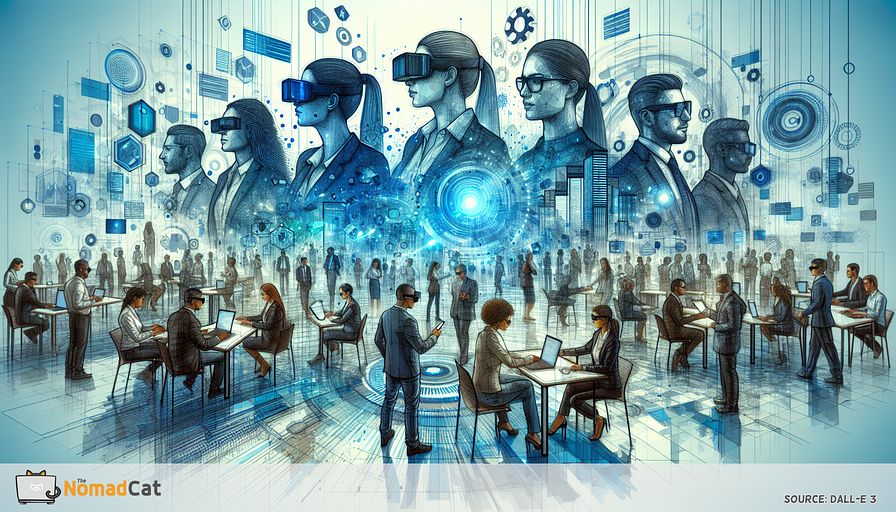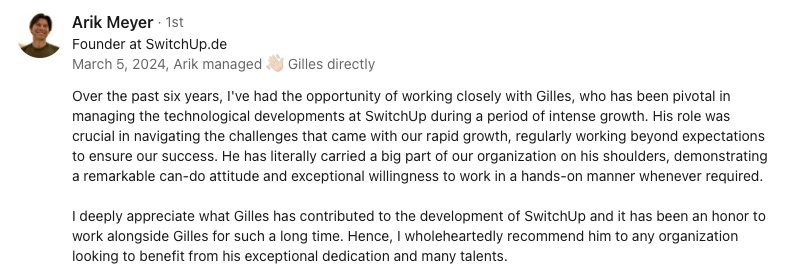Abstract:
Augmented Reality (AR) technology is redefining the boundaries of collaboration and productivity in the workplace. By overlaying digital information onto the physical world, AR enables professionals to interact with data in a more intuitive and immersive manner. This shift not only enhances the efficiency of individual tasks but also fosters better team collaboration, making remote communication as effective as in-person meetings. Businesses are leveraging AR to visualize complex projects, facilitate training, and improve customer service, giving them a competitive edge in the market. The adoption of AR in the workplace signifies a move towards a more interactive and engaging work environment, promising to transform traditional work processes into dynamic, innovative practices. This article explores how AR technology is setting new standards for how we work, collaborate, and innovate, marking a significant milestone in the journey towards the future of work.
AR in the workplace
Augmented Reality (AR) is rapidly gaining traction in many offices and industries. By superimposing digital information onto the physical world, AR opens up new dimensions of interaction and understanding. Imagine looking at a machine and seeing its parts labeled with their functions, or attending a virtual meeting where everyone appears as full-size holograms right in your office. These examples illustrate how AR can transform how we collaborate and complete tasks.
AR technology enhances collaboration and productivity, two critical elements for success in any industry. Particularly in tech and engineering, where visualizing complex data and systems is crucial, AR serves as a valuable tool. For instance, engineers can now visualize project plans in 3D on a table or view real-time alterations in their design models. This not only aids in better understanding but also speeds up the decision-making process by providing intuitive visuals that can be interacted with.
The excitement around AR's transformative potential is palpable. Whether it's training new employees with lifelike simulations or providing real-time guides for complex tasks, AR's applications seem endless. It's about leveraging technology to create an interactive and engaging workspace. As someone who's deeply involved in technology, I genuinely believe that AR will not just enhance, but revolutionize how we work and communicate.
What we're witnessing is the dawn of a new era where our physical and digital worlds merge seamlessly. This blend brings about more efficient workflows and a collaborative environment that's both dynamic and interactive. Such advancements signify the potential for profound improvements in workplace efficiency and employee satisfaction. As we move forward, embracing AR could be the game-changer many of us have been waiting for.
Enhanced collaboration and remote communication
Augmented Reality (AR) is revolutionizing the way teams work together and communicate, especially when members are spread across different locations. AR bridges the gap between in-person and remote interactions, making collaboration seamless and highly effective. It's fascinating to see how AR can simulate the experience of face-to-face meetings, fostering a sense of co-location, even when miles apart.
One of the standout benefits of AR in remote communication is its ability to create immersive environments. Imagine having a meeting where every participant appears as a lifelike 3D avatar in your designated workspace. This setup ensures that everyone feels present, enhancing not just verbal communication but also the subtleties of body language and gestures, which are often lost in conventional video calls.
AR tools and applications for teamwork
Several AR tools and applications have been developed to facilitate better teamwork and efficiency. Here are a few examples:
- Microsoft HoloLens: This device enables users to share and manipulate 3D models in a shared virtual space, making it incredibly useful for engineers and designers collaborating on complex projects. It allows team members to work on the same model, annotate it, and visualize changes in real time.
- Spatial: A popular AR collaboration platform that transforms any space into a shared workspace. It's perfect for brainstorming sessions, as it allows users to pin virtual sticky notes, drawings, and documents around the room. This creates an environment similar to a physical conference room, promoting interactive discussions.
- Google ARCore: This platform supports a suite of AR applications, including collaborative tools that enable remote teams to place, view, and interact with virtual objects in a shared environment. It’s particularly useful in fields like architecture, where visualizing design layouts in actual spaces can significantly impact decision-making.
Boosting productivity and engagement
AR doesn't just enhance communication; it also boosts productivity by making interactions more engaging and efficient. For instance, AR can overlay instruction manuals, workflows, or schematics directly onto the physical equipment a worker is using. This hands-free guidance helps employees follow procedures correctly and efficiently, reducing errors and increasing overall productivity.
An interesting case is remote technical support. Instead of explaining issues over the phone or through emails, technicians can use AR to guide clients visually. They can see what the client sees and provide step-by-step instructions overlaid on the real-world object in question. This method not only resolves issues faster but also ensures a higher level of client satisfaction.
Creating a collaborative atmosphere
Furthermore, AR fosters a truly collaborative atmosphere by allowing joint problem-solving and brainstorming sessions that feel organic. It's remarkable how AR can make remote team members feel like they're working side by side. The technology allows for real-time interactions within the same virtual space, encouraging spontaneous ideas and discussions that often lead to innovative solutions.
To wrap things up, the impact of AR on enhancing remote communication and teamwork is undeniable. It elevates the entire experience, making it more intuitive, engaging, and proficient. By integrating AR, we're not just bridging the gap between remote and in-person work; we're creating a connected workspace that's interactive and dynamic, paving the way for a new standard in collaboration.
Visualization of complex projects
AR provides a powerful platform for visualizing complex projects, allowing professionals to interact with data in a way that feels both intuitive and immersive. This capability significantly aids in problem-solving, enabling teams to see and manipulate project components in real time. When complex data comes to life through AR, understanding and analyzing it becomes much more straightforward.
How AR aids in innovative thinking
One notable advantage of AR is its ability to transform abstract concepts into tangible experiences. For instance, imagine dealing with multi-layered blueprints or intricate engineering designs. Traditional 2D representations can sometimes miss the mark. However, with AR, professionals can overlay these blueprints onto a physical space, rotating, scaling, and even disassembling parts to gain deeper insights. This level of interaction fosters innovative thinking, as it opens up new perspectives and avenues for exploration.
Industries like construction and aerospace significantly benefit from this AR-driven visualization. In construction, site managers can walk through a virtual model of a building before a single brick is laid. This preemptive approach helps in identifying potential issues and making adjustments early on, saving time and resources. Similarly, in aerospace, engineers can visualize the complex wiring and component assembly of an aircraft, ensuring that everything is in its rightful place, thereby reducing the margin for error.
Improving problem-solving with real-time interaction
Another remarkable feature of AR is the ability to interact with project elements as if they were physically present. By using AR glasses or mobile devices, teams can collaborate on a virtual model, discussing changes and making modifications on the spot. This real-time interaction is invaluable for problem-solving. For example, medical professionals can use AR to visualize brain scans in 3D, helping them understand the exact location of anomalies and plan surgeries with higher precision.
Moreover, AR can be a game-changer in the automotive industry. Designers and engineers can visualize car models, tweak designs, and assess ergonomics simultaneously. This integration between design and functionality streamlines the entire development process, resulting in faster iterations and a more cohesive final product.
Key benefits across various sectors
The application of AR in visualizing complex projects spans across numerous sectors:
- Architecture: AR allows architects to present their designs in a lifelike manner, giving clients a clearer picture of the final outcome. It also helps in identifying structural issues before actual construction begins.
- Manufacturing: Engineers can overlay models on physical machines, making it easier to understand assembly lines and spot inefficiencies.
- Healthcare: AR enhances the visualization of anatomical structures, providing surgeons with a better understanding and improving surgical outcomes.
- Education: Students can interact with complex scientific models, making abstract concepts more tangible and easier to comprehend.
The ability to visualize projects in such detail is a significant breakthrough. By making data more accessible and interactive, AR not only streamlines problem-solving but also sparks innovative ideas. In my experience, integrating AR into our workflow has transformed how we approach complex projects, leading to more informed decisions and superior results. The potential of AR in professional settings is expansive, and I'm excited to see how it will continue to evolve and enhance our capabilities.
AR in training and customer service
In today's fast-paced environment, Augmented Reality (AR) has emerged as a powerful tool for training employees and enhancing customer service. Integrating AR into training programs brings significant advantages by offering interactive and engaging learning experiences. For instance, instead of traditional manuals, new employees can now receive hands-on training through AR applications that superimpose step-by-step guides onto real-world objects. This immersive approach not only improves understanding but also keeps trainees engaged and motivated.
Transforming employee training programs
I have witnessed how AR-based training programs can significantly enhance learning outcomes. Instead of just hearing about a procedure, employees can see and practice it in a controlled, virtual environment. Here are ways AR is transforming training:
- Realistic simulations: Employees can engage in lifelike simulations of their tasks, ranging from operating machinery to customer interactions. These simulations provide a safe space to practice and learn from mistakes without real-world consequences.
- On-demand learning: AR allows employees to access training modules whenever needed. For example, a maintenance worker can scan a faulty machine part and receive instant, on-the-spot guidance for repairs.
- Enhanced retention: The interactive nature of AR helps in better retention of information. When trainees can see and manipulate objects in a 3D space, the learning experience becomes more memorable and effective.
Revolutionizing customer service
AR's applications extend beyond employee training to revolutionize customer service. Real-time AR guidance can greatly improve the customer experience. Imagine customers receiving AR-enabled support that visualizes instructions over their immediate surroundings. This technology can provide clear, step-by-step assistance directly in their field of view.
- Interactive manuals: Instead of static instruction booklets, customers can use AR to see animated, 3D walkthroughs of product setup and troubleshooting, making the process simpler and more intuitive.
- Remote assistance: With AR, support agents can see exactly what the customer sees and provide visual guidance to resolve issues. This reduces the back-and-forth typically involved in traditional support methods.
- Personalized shopping experiences: Retailers can offer AR shopping experiences where customers visualize how products look and fit in their homes before making a purchase, leading to higher satisfaction and lower return rates.
The impact of AR on both training and customer service is substantial. By offering immersive and interactive experiences, AR not only boosts employee engagement but also enhances customer satisfaction. From my perspective as a technology leader, leveraging these capabilities is a strategic imperative to stay ahead in a highly competitive market. As AR continues to evolve, its potential to redefine learning and service processes is truly immense, promising a future where interaction and efficiency go hand in hand.
Competitive edge through AR adoption
Adopting Augmented Reality (AR) technology can catapult businesses ahead of their competitors by introducing innovative practices and creating new value propositions. Early adopters of AR often enjoy unique advantages that set them apart and positioning them as leaders in their respective industries. The key lies in leveraging AR to improve processes, enhance customer experiences, and drive operational efficiency.
Innovative practices of early adopters
Companies that integrate AR early on can transform their operations in several ways. For example, manufacturing firms utilizing AR for quality control can detect defects in real-time, reducing waste and ensuring high-quality output. Employees equipped with AR devices can access step-by-step guides overlaid on their workspace, simplifying complex tasks and minimizing errors.
In the retail sector, some businesses harness AR to create interactive shopping experiences. Consider IKEA's use of the IKEA Place app, which allows customers to visualize furniture in their homes before purchasing. This not only improves customer satisfaction but also reduces return rates, translating to cost savings and better customer retention.
Advantages of AR integration
Integrating AR into business processes brings tangible benefits:
- Enhanced productivity: Teams equipped with AR tools can complete tasks faster and with greater accuracy. This operational efficiency can lead to significant cost savings and higher throughput.
- Improved training: AR-facilitated training programs can reduce the time required to onboard new employees and improve skill retention. This ensures a more competent and confident workforce ready to meet business challenges.
- Superior customer engagement: Businesses can use AR to offer personalized and immersive customer experiences. From virtual try-ons in fashion retail to interactive product tours in real estate, the possibilities are vast and impactful.
- Real-time collaboration: AR enables real-time collaboration across dispersed teams, breaking down geographical barriers. This can accelerate project timelines and foster a culture of innovation and teamwork.
Real-world examples
One compelling example is Boeing, which uses AR to assist technicians in wiring 787 Dreamliners. By overlaying wire schematics directly onto the aircraft, AR has significantly reduced production time and errors. This approach demonstrates the power of AR in optimizing intricate processes and maintaining high standards.
Another noteworthy example is the use of AR by the automotive giant, BMW. BMW uses AR to enhance the customer experience by allowing potential buyers to visualize different car models, colors, and configurations in their driveways. This immersive sales tool has helped BMW capture the interest of tech-savvy customers and streamline the purchasing process.
Incorporating AR into business strategies provides a distinct competitive advantage. From enhanced operational efficiency to superior customer engagement, the benefits of AR are substantial. As a Chief Technology Officer, I see AR as not just a tool but a strategic asset that can redefine success in any industry.
Future of work: interactive and dynamic
Reflecting on the potential of AR technology, it's evident that it will fundamentally reshape our work environments into more interactive and dynamic spaces. Augmented Reality holds the promise of transforming the traditional office into a place where physical and digital elements coexist seamlessly. The implications for how we work and collaborate are immense, fostering innovation and efficiency on multiple levels.
Driving innovation and creativity
I foresee AR as a pivotal driver of innovation and creativity in the workplace. By offering immersive and interactive ways to engage with information, AR can break down complex problems into manageable components. Teams can brainstorm in virtual environments that adapt and change according to their needs, fostering a culture of creativity and agile thinking. The ability to manipulate 3D models, simulations, and data in real-time can spur innovative solutions that were previously unimaginable using conventional tools.
Transforming workplace dynamics
AR's ability to meld the physical and digital worlds will lead to workflows that are more integrated and efficient. For instance, think about virtual workspaces where colleagues can gather, interact, and collaborate from anywhere in the world, all while maintaining the sense of presence and engagement of in-person meetings. This shift can significantly reduce the barriers posed by geographical distances, making remote work more viable and productive.
Enhancing employee engagement and satisfaction
Moreover, integrating AR into daily tasks can lead to higher levels of employee engagement and satisfaction. When work becomes interactive and visually dynamic, it appeals more to employees, making their tasks less mundane. Real-time feedback and visually rich interfaces can transform routine activities into engaging experiences, thereby boosting morale and job satisfaction.
Shaping the workspace of tomorrow
Looking ahead, AR is set to redefine the workplace in ways we are only beginning to comprehend. From enhancing design and engineering processes to revolutionizing customer interactions, the potential is vast. As we integrate AR, the future workspace will be one where flexibility, creativity, and collaboration thrive. The evolving capabilities of AR will not only improve how we work but also open new avenues for professional growth and innovation.
In my role as a technology leader, the prospect of what AR can achieve excites me. Embracing these advancements means preparing for a future where the lines between physical and digital are continuously blurred, creating an environment that inspires and drives progress. We are on the brink of a transformative era, with AR poised to lead the way in redefining how we perceive and interact within our workspaces.
You might be interested by these articles:
- Holographic Collaboration Tools
- Augmenting Reality in the Workplace
- Augmented reality's green revolution in sustainable innovation





